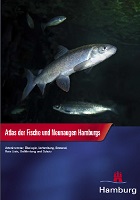Atlas of fish and lampreys of Hamburg

The ruffe, gudgeon and bitterling are just a few of the fish species that are native to the waters of Hamburg's urban area. Prof. Dr. Ralf Thiel and Renate Thiel from the Center for Natural History (CeNak) at the University of Hamburg were commissioned by the Department of Urban Development and the Environment (BSU) of the Free and Hanseatic City of Hamburg to analyze the status of their populations, what makes them endangered and how they can best be protected. In addition, existing data from more than 100 years were included. Based on the research results, the BSU has now published the "Atlas of fish and lampreys of Hamburg", which also includes an assessment of the situation in the Hamburg Wadden Sea National Park.
The evaluations show that a total of 57 fish and lamprey species from 20 families are recorded in the Hamburg urban area. Seven of these species are so-called neozoa, meaning that they have migrated or been introduced from another region. These include, for example, the blackmouth goby, the sunfish and the American dwarf dogfish. Based on their fish fauna, the habitat quality of the Elbe/Hafen, Alster, Bille, Moorburger Landscheide, Düpenau, Este, Seevekanal and Wedeler Au water systems was assessed.
A major focus was also a threat analysis for fish species living in Hamburg waters. The seven neozoa were not considered in this assessment. Of the remaining 50 species, a total of eleven (22%) are endangered, such as the brook lamprey and the mud whiptail. The Atlantic salmon is even threatened with extinction. Already considered extinct or extinct are the European sturgeon and the allis shad; the grayling is "extremely rare." "A total of 14 species have thus been placed in a Red List category," says Prof. Ralf Thiel, head of the Department of Ichthyology at CeNak at the University of Hamburg, summarizing the results.
In the Hamburg Wadden Sea National Park, in the Elbe estuary off Cuxhaven, 59 species were counted, of which nine are endangered and seven are on the forewarned list. For eight species the data situation is not sufficient for an assessment. Five of the endangered species in the national park are also listed in the European Union's 1992 Fauna-Flora-Habitat Directive, which designates species and habitats in need of special protection.
The study shows that populations of a whole range of species have declined since the mid-19th century, making auxiliary or protective measures necessary in the Hamburg Wadden Sea as well as the urban area. "Compared to the last study in 1991, many species have recovered significantly, but further steps still need to be taken," Thiel said. For example, he said, the passability of flowing waters for the animals must be further improved.
According to the fish species atlas, in addition to waterway construction and maintenance, the main threats to fish fauna in Hamburg's urban area are nutrient and pollutant pollution, as well as the use of cooling water and climate change. In the Wadden Sea, further habitat changes caused by humans as well as fishing are added.
The data basis of the analysis were about 4500 sampling from a period from the middle of the 19th century to 2013, which were filed in the species register of the Authority for Urban Development and Environment. Thus, not only the current situation can be presented, but also a long-term development. The last comprehensive representation of Hamburg's fish fauna dates back to 1991. Prof. Thiel explains, "The new species atlas is another example of the successful cooperation between the Authority for Urban Development and the Environment and the University of Hamburg."
Related links
For inquiries:
Prof. Dr. Ralf Thiel
Tel.: +49 40 42838-5637
E-Mail: Ralf.Thiel"AT"uni-hamburg.de

